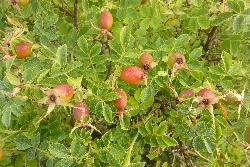- Taxon
- Weed
- Gallery
- = Rosa eglanteria L., Sp. Pl. 491 (1753)
Deciduous, rather erect, sometimes dense shrub 1–3–(5) m high, often with suckers; stems ± erect except in young plants, often with glandular hairs when young, otherwise glabrous; armature of few to numerous, unequal, flattened, moderately curved to strongly falcate prickles and pricklets, and sometimes acicles. Lvs with 2–3–(4) pairs of leaflets; petiole 10–25 mm long, ± finely tomentose and with glandular hairs and scattered pricklets; stipules completely adnate, generally clothed in very short glandular hairs, fringed with numerous small glandular hairs. Lamina of leaflets 12–40–(50) × 8–28–(35) mm, broadly elliptic to elliptic-obovate, sometimes suborbicular, dull green and glabrous above, with ± numerous, ± subsessile, pale glands beneath and with eglandular hairs on veins, sometimes hairs dense on midrib; margins ± 2-serrate, with glandular hairs; base rounded; apex acute or subacute, sometimes rounded. Fls 1–3–(6), single, (20)–25–40 mm diam.; pedicels usually with many hispid glands. Sepals ± persistent, lanceolate to ovate, long-acuminate or sometimes with an expanded apical tail, tomentose inside, ± densely clothed in stiff, spreading glandular hairs outside and on margins; outer sepals pinnatisect with a few linear to narrowly elliptic lobes. Petals (8)–12–20 mm long, obovate or cuneiform, pink or deep pink (especially in bud) except for whitish base. Styles free, slightly exserted, densely hairy or villous. Fr. (10)–12–22–(28) × (8)–10–18–(20) mm, broadly ovoid, broadly ellipsoid, urceolate, ellipsoid-obovoid, subglobose or globose, occasionally narrow-ellipsoid (sterile aneuploids), red or orange-red, usually glabrous except at base, sometimes with dark red hispid glands.
[From: Webb et al. (1988) Flora of New Zealand. Volume 4.]
Flowering: Nov.–Jan.; Fruiting: Feb.–May.




